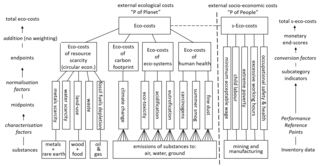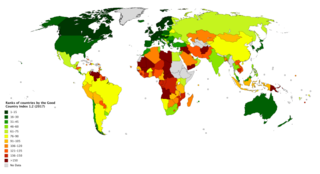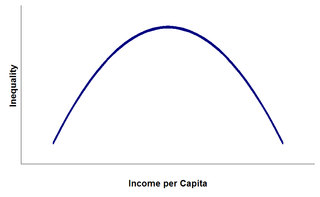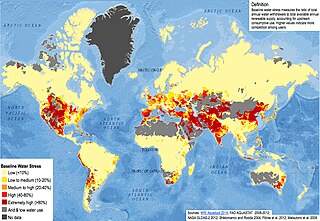 W
WAviation taxation and subsidies includes taxes and subsidies related to aviation.
 W
WA circular economy is an economic system aimed at eliminating waste and the continual use of resources. Circular systems employ reuse, sharing, repair, refurbishment, remanufacturing and recycling to create a closed-loop system, minimising the use of resource inputs and the creation of waste, pollution and carbon emissions. The circular economy aims to keep products, equipment and infrastructure in use for longer, thus improving the productivity of these resources. All "waste" should become "food" for another process: either a by-product or recovered resource for another industrial process or as regenerative resources for nature. This regenerative approach is in contrast to the traditional linear economy, which has a "take, make, dispose" model of production.
 W
WDegrowth is a term used for both a political, economic, and social movement as well as a set of theories that critiques the paradigm of economic growth. It is based on ideas from a diverse range of lines of thought such as political ecology, ecological economics, feminist political ecology, and environmental justice. Degrowth emphasizes the need to reduce global consumption and production and advocates a socially just and ecologically sustainable society with well-being replacing GDP as the indicator of prosperity. Degrowth highlights the importance of autonomy, care work, self-organization, commons, community, localism, work sharing, happiness and conviviality.
 W
WEco-costs are the costs of the environmental burden of a product on the basis of prevention of that burden. They are the costs which should be made to reduce the environmental pollution and materials depletion in our world to a level which is in line with the carrying capacity of our earth.
 W
WThe Eco-Management and Audit Scheme (EMAS) is a voluntary environmental management instrument, which was developed in 1993 by the European Commission. It enables organizations to assess, manage and continuously improve their environmental performance. The scheme is globally applicable and open to all types of private and public organizations. In order to register with EMAS, organisations must meet the requirements of the EU EMAS-Regulation. Currently, more than 4,600 organisations and more than 7,900 sites are EMAS registered.
 W
WEcological economics, bioeconomics, ecolonomy, or eco-economics, is both a transdisciplinary and an interdisciplinary field of academic research addressing the interdependence and coevolution of human economies and natural ecosystems, both intertemporally and spatially. By treating the economy as a subsystem of Earth's larger ecosystem, and by emphasizing the preservation of natural capital, the field of ecological economics is differentiated from environmental economics, which is the mainstream economic analysis of the environment. One survey of German economists found that ecological and environmental economics are different schools of economic thought, with ecological economists emphasizing strong sustainability and rejecting the proposition that physical (human-made) capital can substitute for natural capital.
 W
WEnergy quality is a measure of the ease at which a form of energy can be converted to useful work or to another form of energy. A high quality form of energy is easily converted to work or to a lower quality form of energy, whereas converting low quality forms of energy to work or a higher quality form may be inefficient, difficult or impossible. The concept of energy quality is also used in ecology, where it is used to track the flow of energy between different trophic levels in a food chain and in thermoeconomics, where it is used as a measure of economic output per unit of energy. Methods of evaluating energy quality often involve developing a ranking of energy qualities in hierarchical order.
 W
WOne can define economic growth as the increase in the inflation-adjusted market value of the goods and services produced by an economy over time. Statisticians conventionally measure such growth as the percent rate of increase in real gross domestic product, or real GDP.
 W
WIn economics, an externality is the cost or benefit that is imposed by one or several parties on a third party who did not agree to incur that cost or benefit. The concept of externality was first developed by economist Arthur Pigou in the 1920s.
 W
WGenuine progress indicator (GPI) is a metric that has been suggested to replace, or supplement, gross domestic product (GDP). The GPI is designed to take fuller account of the well-being of a nation, only a part of which pertains to the size of the nation's economy, by incorporating environmental and social factors which are not measured by GDP. For instance, some models of GPI decrease in value when the poverty rate increases. The GPI separates the concept of societal progress from economic growth.
 W
WThe Good Country Index measures how much each of the 163 countries on the list contribute to the planet, and to the human race, through their policies and behaviors.
 W
WThe Green Collar Economy: How One Solution Can Fix Our Two Biggest Problems is a 2008 book by Van Jones. It outlines a plan for simultaneously solving socioeconomic inequality and environmental problems. The book has received favorable reviews from Al Gore, Nancy Pelosi, Laurie David, Paul Hawken, Winona LaDuke and Ben Jealous. The Green Collar Economy is the first environmental book written by an African-American to make the New York Times bestseller list.
 W
WGross National Happiness is a philosophy that guides the government of Bhutan. It includes an index which is used to measure the collective happiness and well-being of a population. Gross National Happiness Index is instituted as the goal of the government of Bhutan in the Constitution of Bhutan, enacted on 18 July 2008.
 W
WThe Human Development Index (HDI) is a statistic composite index of life expectancy, education, and per capita income indicators, which are used to rank countries into four tiers of human development. A country scores a higher HDI when the lifespan is higher, the education level is higher, and the gross national income GNI (PPP) per capita is higher. It was developed by Pakistani economist Mahbub ul Haq and was further used to measure a country's development by the United Nations Development Programme (UNDP)'s Human Development Report Office.
 W
WThe International Institute for Applied Systems Analysis (IIASA) is an independent international research institute located in Laxenburg, near Vienna, in Austria. Through its research programs and initiatives, the institute conducts policy-oriented interdisciplinary research into issues too large or complex to be solved by a single country or academic discipline. This includes pressing concerns that affect the future of humanity, such as climate change, energy security, population aging, and sustainable development. The results of IIASA research and the expertise of its researchers are made available to policymakers in countries around the world to help them produce effective, science-based policies that will enable them to face these challenges.
 W
WIn economics, a Kuznets curve graphs the hypothesis that as an economy develops, market forces first increase and then decrease economic inequality. The hypothesis was first advanced by economist Simon Kuznets in the 1950s and 1960s.
 W
WIn the United States, an environmental site assessment is a report prepared for a real estate holding that identifies potential or existing environmental contamination liabilities. The analysis, often called an ESA, typically addresses both the underlying land as well as physical improvements to the property. A proportion of contaminated sites are "brownfield sites." In severe cases, brownfield sites may be added to the National Priorities List where they will be subject to the U.S. Environmental Protection Agency's Superfund program.
 W
WIn environmental law, the polluter pays principle is enacted to make the party responsible for producing pollution responsible for paying for the damage done to the natural environment. It is regarded as a regional custom because of the strong support it has received in most Organisation for Economic Co-operation and Development (OECD) and European Union countries. It is a fundamental principle in US environmental law.
 W
WThe pollution haven hypothesis posits that, when large industrialized nations seek to set up factories or offices abroad, they will often look for the cheapest option in terms of resources and labor that offers the land and material access they require. However, this often comes at the cost of environmentally unsound practices. Developing nations with cheap resources and labor tend to have less stringent environmental regulations, and conversely, nations with stricter environmental regulations become more expensive for companies as a result of the costs associated with meeting these standards. Thus, companies that choose to physically invest in foreign countries tend to (re)locate to the countries with the lowest environmental standards or weakest enforcement.
 W
WSocial metabolism or socioeconomic metabolism is the set of flows of materials and energy that occur between nature and society, between different societies, and within societies. These human-controlled material and energy flows are a basic feature of all societies but their magnitude and diversity largely depend on specific cultures, or sociometabolic regimes. Social or socioeconomic metabolism is also described as "the self-reproduction and evolution of the biophysical structures of human society. It comprises those biophysical transformation processes, distribution processes, and flows, which are controlled by humans for their purposes. The biophysical structures of society and socioeconomic metabolism together form the biophysical basis of society."
 W
WThe tragedy of the commons is a situation in a shared-resource system where individual users, acting independently according to their own self-interest, behave contrary to the common good of all users by depleting or spoiling the shared resource through their collective action. The concept originated in an essay written in 1833 by the British economist William Forster Lloyd, who used a hypothetical example of the effects of unregulated grazing on common land in Great Britain and Ireland. The concept became widely known as the "tragedy of the commons" over a century later after an article written by Garrett Hardin in 1968. In a modern economic context, "commons" is taken to mean any shared and unregulated resource such as the atmosphere, oceans, rivers, ocean fish stocks, or even an office refrigerator.
 W
WWater scarcity is the lack of fresh water resources to meet the standard water demand. Humanity is facing a water crisis, due to unequal distribution resulting in some very wet and some very dry geographic locations, plus a sharp rise in global freshwater demand in recent decades driven by industry. Water scarcity can also be caused by droughts, lack of rainfall, or pollution. This was listed in 2019 by the World Economic Forum as one of the largest global risks in terms of potential impact over the next decade. It is manifested by partial or no satisfaction of expressed demand, economic competition for water quantity or quality, disputes between users, irreversible depletion of groundwater, and negative impacts on the environment. Two-thirds of the global population live under conditions of severe water scarcity at least 1 month of the year. Half a billion people in the world face severe water scarcity all year round. Half of the world's largest cities experience water scarcity.
 W
WIn environmental policy, white certificates are documents certifying that a certain reduction of energy consumption has been attained. In most applications, the white certificates are tradable and combined with an obligation to achieve a certain target of energy savings. Under such a system, producers, suppliers or distributors of electricity, gas and oil are required to undertake energy efficiency measures for the final user that are consistent with a pre-defined percentage of their annual energy deliverance. If energy producers do not meet the mandated target for energy consumption they are required to pay a penalty. The white certificates are given to the producers whenever an amount of energy is saved whereupon the producer can use the certificate for their own target compliance or can be sold to (other) parties who cannot meet their targets. Quite analogous to the closely related concept of emissions trading, the tradability in theory guarantees that the overall energy saving is achieved at least cost, while the certificates guarantee that the overall energy saving target is achieved.